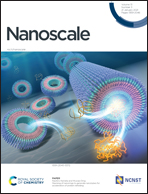Surface roughness and substrate induced symmetry-breaking: influence on the plasmonic properties of aluminum nanostructure arrays†
Abstract
The surface topography is known to play an important role on the near- and far-field optical properties of metallic nanoparticles. In particular, aluminum (Al) nanoparticles are commonly fabricated through evaporation techniques, therefore exhibiting elevated surface roughness additionally to their native oxide layer. In this study, the mode-dependent influence of surface roughness on the plasmonic properties sustained by Al nanodisks (NDs) is first numerically investigated using a realistic model taking into account the thin native oxide layer. Due to the symmetry-breaking induced by the supporting dielectric substrate to Al ND, it appears that the roughness affects differently the substrate-induced out-of-plane quadrupolar mode (below 300 nm) and the in-plane dipolar mode sustained by the Al ND. By increasing the top surface roughness of the Al ND, the substrate-induced quadrupolar mode is significantly damped especially in the ultraviolet regime, while the dipolar resonance is broadened and redshifted. The explanation of these effects relies in the decoherence and dissipation of the collective electronic oscillations as a result of the top surface roughness to the different near-field distribution of the out-of-plane quadrupolar mode and in-plane dipolar mode. Moreover, the influences of the diameter of Al ND, dielectric substrate with different refractive index, and the oxidation of Al ND on these two modes are also investigated. Particularly, the quadrupolar mode disappears with surface roughness and oxidation, explaining why this mode is very weak and sometimes barely visible on evaporated Al nanostructures reported in the literature. Finally, these results are experimentally confirmed by characterizing the optical properties of periodic Al ND arrays.



 Please wait while we load your content...
Please wait while we load your content...